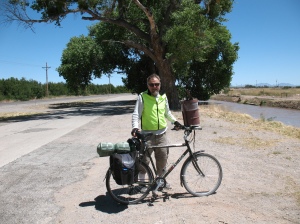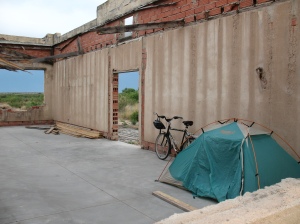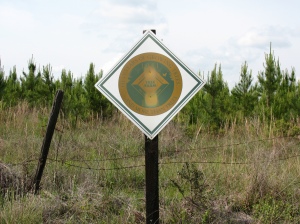South from Alaska: Reflections on Traveling the U.S. and Visiting FHS
 We’ve asked Jim Mackovjak, author of the forthcoming FHS book, Tongass Timber: A History of Logging and Timber Utilization in Southeast Alaska, 1804-1960, to share his thoughts on his recent cross-country bike trip and his time here in Durham. Around our office he has earned the nickname “Lawrence of Alaska” for his ride through the American desert.
We’ve asked Jim Mackovjak, author of the forthcoming FHS book, Tongass Timber: A History of Logging and Timber Utilization in Southeast Alaska, 1804-1960, to share his thoughts on his recent cross-country bike trip and his time here in Durham. Around our office he has earned the nickname “Lawrence of Alaska” for his ride through the American desert.When I left San Diego on my bicycle trip across the country two months ago, I envisioned evenings spent camped behind roadside billboards and nourishing meals of road-killed animal parts that, cooked over an open fire, would invariably taste like chicken. Not really. But though I had done little planning, I knew which way to go: head into the morning sun and keep Mexico on my right. Despite the facts that I had not trained at all and my equipment was very basic (though sound), some 50 gallons of Gatorade and five and a half weeks later I arrived safely in St. Augustine, Florida, none the worse for wear.
The hot, southern tier of the United States is not my customary environ. I hail from the small town of Gustavus, in southeast Alaska, where I have resided for forty years. Southeast Alaska’s climate is a bit harsh, but it is truly a region of great natural abundance, both terrestrial and marine, and offers a stark contrast to the three deserts I crossed. The bicycle ride was a lark, something I had wanted to do since I was a teenager, but work and family responsibilities had always prevented. These days, I do contract writing and my wife teaches school, and our three children are grown and off pretty much on their own. I made time for the trip.
Some of the stretches through the deserts were long, hot, and lonely, and, in my own small way, at the end of a day’s riding I felt like Lawrence of Arabia emerging from the desert on a bicycle. The first real trees I saw along the route, a juniper-like species in the hill country of Texas that reached a size that would at least provide a modicum of shade, were a welcome sight. I relished the increasing amounts of greenery as I journeyed east. I understand the importance of the pineries of the southeastern states to our nation’s wood supply, and the plantation forests, with their neat rows of evenly-spaced trees, were of great interest to me. But constantly feeling the need to push east, I never made a serious effort to learn more about them firsthand. I nevertheless enjoyed the shade they provided.

Jim Mack traveling in Texas. Trees took on a new significance to this “Lawrence of Alaska” as he biked through three deserts.
One question that I often asked myself while pedaling along was: What am I learning? I’m still not sure what the answer is, other than the fact that I had the strength and stamina to complete the trip.
I have been involved in Alaska forest issues for many years, and lamented the lack of a comprehensive history of the forest products industry in Southeast Alaska. Much of the historical record, it seemed to me, was comprised of hearsay that had been repeated for so long that it had become accepted as fact. I was presented with an opportunity to rectify that situation. In 2002, to provide our children with educational opportunities not available in Gustavus, we began spending school years in Eugene, Oregon. The routine continued for five years. Not long after arriving in Eugene I discovered that the library at the University of Oregon had an incredible collection of timber trade publications that dated from the early 1900s. I began spending my afternoons systematically going through them page by page (most are not indexed and lack even a table of contents) for references to Southeast Alaska. It was a very enjoyable endeavor.
There wasn’t a lot written about Southeast Alaska, particularly in the early years, but there was enough to give me a solid idea what was going on from the perspective of industry as well as that of government officials. The Forest Service was determined to establish a world-class newsprint paper manufacturing industry in the region, and missed few opportunities to promote its endeavor. I decided to put together a manuscript of the wood products industry in Southeast Alaska from its inception with the Russians in the early 1800s through 1960, when what I refer to Southeast Alaska’s “pulp mill era” began. The information I gathered from the trade publications, as well as publications such as Journal of Forestry, provided the framework for the history. This was later beefed up with information from archives and other sources.

Aerial view of experimental block-cutting of timber on the Tongass National Forest in Alaska, 1958 (Click image to see gallery of Alaska photos).
In Portland, Oregon, I was introduced to Bill Hagenstein, America’s oldest practicing forester and a former board member of the Forest History Society. Through him I became acquainted with the Society, which took an interest in the manuscript and later agreed to publish it. Generous grants from the Alaska Humanities Forum and several individuals and foundations have facilitated the process. The manuscript has been edited and peer reviewed, and a collection of photographs and other images has been amassed at the Forest History Society.
By coincidence, Steve Anderson, who heads the Forest History Society, had also crossed the country on a bicycle. In 1976, he and several friends bicycled from New Jersey to Seattle, where Steve began a master’s program at the University of Washington. Steve was interested in my trip and also urged me to make time to visit the Forest History Society’s office in Durham. I took him up on the offer.
At this moment, I am sitting at a desk at the Forest History Society, where Steve and I are reviewing my manuscript in preparation for the book design process. Except for a small window, I am literally surrounded by books and reports on forests. The facility is crowded, but with—to my mind—the right kind of stuff. To anyone interested in our forests and their history, the Forest History Society’s collection is a gold mine, and it is difficult for me to keep my eyes from wandering to the book shelves, because I know I will see something that will distract me from the task at hand. I joked yesterday that there is so much good material here that I could be blindfolded and sent into the stacks and the first book I picked out would be something I would want to look through. To test my theory, I later closed my eyes, went into the stacks, and picked out a book that, yes, looked interesting.
The Forest History Society’s collection is mostly “old school” hard-copy material. There are many advantages to a researcher in having access to hard-copy material. It allows us to browse relevant material in an efficient manner not possible with digital files or where material is stored off-site. Library catalogs are a good place to begin searching for material, but looking at a collection in person is, for me, more efficient and greatly preferred. I can quickly scan titles and once I have pulled a publication off a shelf I can usually assess its value for my purposes in a matter of seconds. And I have at times been greatly rewarded by perusing the books on the shelf relating to a given topic. Of course, there is nothing that can replace the most venerable search engine known: the competent librarian. I knew this before I left San Diego but relearned it during this time in Durham.
I am impressed with what I see at the Forest History Society, and hope that its collection can be maintained, remain accessible, and continue to grow. I encourage you to come visit, whether by car or by bike.



